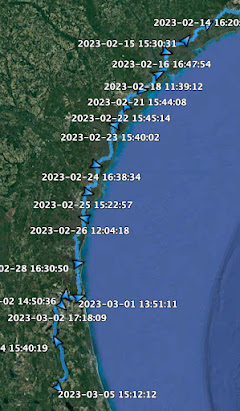It's not a dance, though it could be.
It's called the electric chicken. Not the lure itself, but the color pattern. A little chartreuse, with silver flakes mixed in, and pink on top. The lure is a five inch sea shad with a paddle tail, my next experiment in a never ending search for a shallow water, weedless fishing lure. This is a technique Ihave borrowed from the guys at the
Texas kayak fishing site. They often "troll" rigs like this behind their kayaks in just a foot or two of water.
I've forgotten the name of the hook. It has a very small amount of weight, maybe one-eighth of an ounce, molded onto the shaft. He hook is buried into the shad so that it does not catch on weeds, oystershells or whatever. The idea is that the point of the hook comes out only when a fish bites down on the lure.
I will be fishing on both my Tangier Sound and North Carolina trips. On the open waters of Tangier Sound I'll be trolling larger hard plastic lures with a lip that causes the lure to dive six or eight feet under the surface of the water. That works well for catching bluefish, above, out in the open water.
In shallow water it is another story. The shallow water, up along the islands or over oyster reefs, are where the striper hang out. The larger lures, with treble hooks that hang beneath, tend to catch on the subaquatic grasses and shells. The electric chicken is my newest attempt at a solution. I can see slowly skirting the islands of Tangier Sound, maybe under just mizzen and jib, with the shad trolled behind Spartina.
I've had varying levels of success at fishing from Spartina. Over the years I have had dinners of fresh caught speckled trout, bluefish and, below, striper. On the Tangier Sound trip I'll be looking for stripers and bluefish. A few weeks later I'll be on the hunt for speckled trout, puppy drum and flounder down near Cape Lookout in North Carolina. Sometimes I catch, sometimes I don't. But I always have fun.
I will say that I've read reports that, because of the mild winter, the Bay is coming alive earlier than usual. Crabbing, both for hard shells and soft shells, is picking up. And the fish should be a little more active than usual. We'll see.
steve






























































































